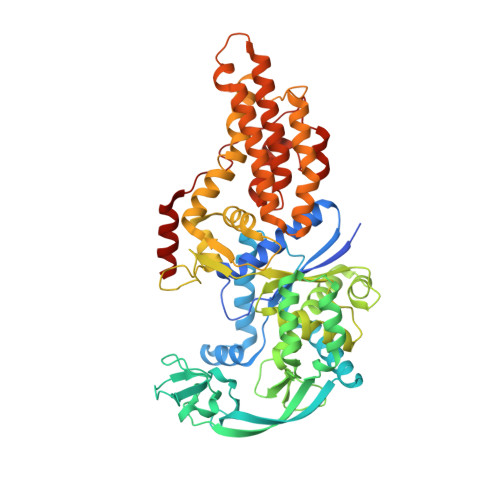Redesigning methionyl-tRNA synthetase for beta-methionine activity with adaptive landscape flattening and experiments.
Opuu, V., Nigro, G., Lazennec-Schurdevin, C., Mechulam, Y., Schmitt, E., Simonson, T.(2023) Protein Sci 32: e4738-e4738
- PubMed: 37518893
- DOI: https://doi.org/10.1002/pro.4738
- Primary Citation of Related Structures:
8BRU, 8BRV, 8BRW, 8BRX - PubMed Abstract:
Amino acids (AAs) with a noncanonical backbone would be a valuable tool for protein engineering, enabling new structural motifs and building blocks. To incorporate them into an expanded genetic code, the first, key step is to obtain an appropriate aminoacyl-tRNA synthetase. Currently, directed evolution is not available to optimize AAs with noncanonical backbones, since an appropriate selective pressure has not been discovered. Computational protein design (CPD) is an alternative. We used a new CPD method to redesign MetRS and increase its activity towards β-Met, which has an extra backbone methylene. The new method considered a few active site positions for design and used a Monte Carlo exploration of the corresponding sequence space. During the exploration, a bias energy was adaptively learned, such that the free energy landscape of the apo enzyme was flattened. Enzyme variants could then be sampled, in the presence of the ligand and the bias energy, according to their β-Met binding affinities. Eighteen predicted variants were chosen for experimental testing; 10 exhibited detectable activity for β-Met adenylation. Top predicted hits were characterized experimentally in detail. Dissociation constants, catalytic rates, and Michaelis constants for both α-Met and β-Met were measured. The best mutant retained a preference for α-Met over β-Met; however, the preference was reduced, compared to the wildtype, by a factor of 29. For this mutant, high resolution crystal structures were obtained in complex with both α-Met and β-Met, indicating that the predicted, active conformation of β-Met in the active site was retained.
- Laboratoire de Biologie Structurale de la Cellule (CNRS UMR7654), Ecole Polytechnique, Institut Polytechnique de Paris, Palaiseau, France.
Organizational Affiliation:



















